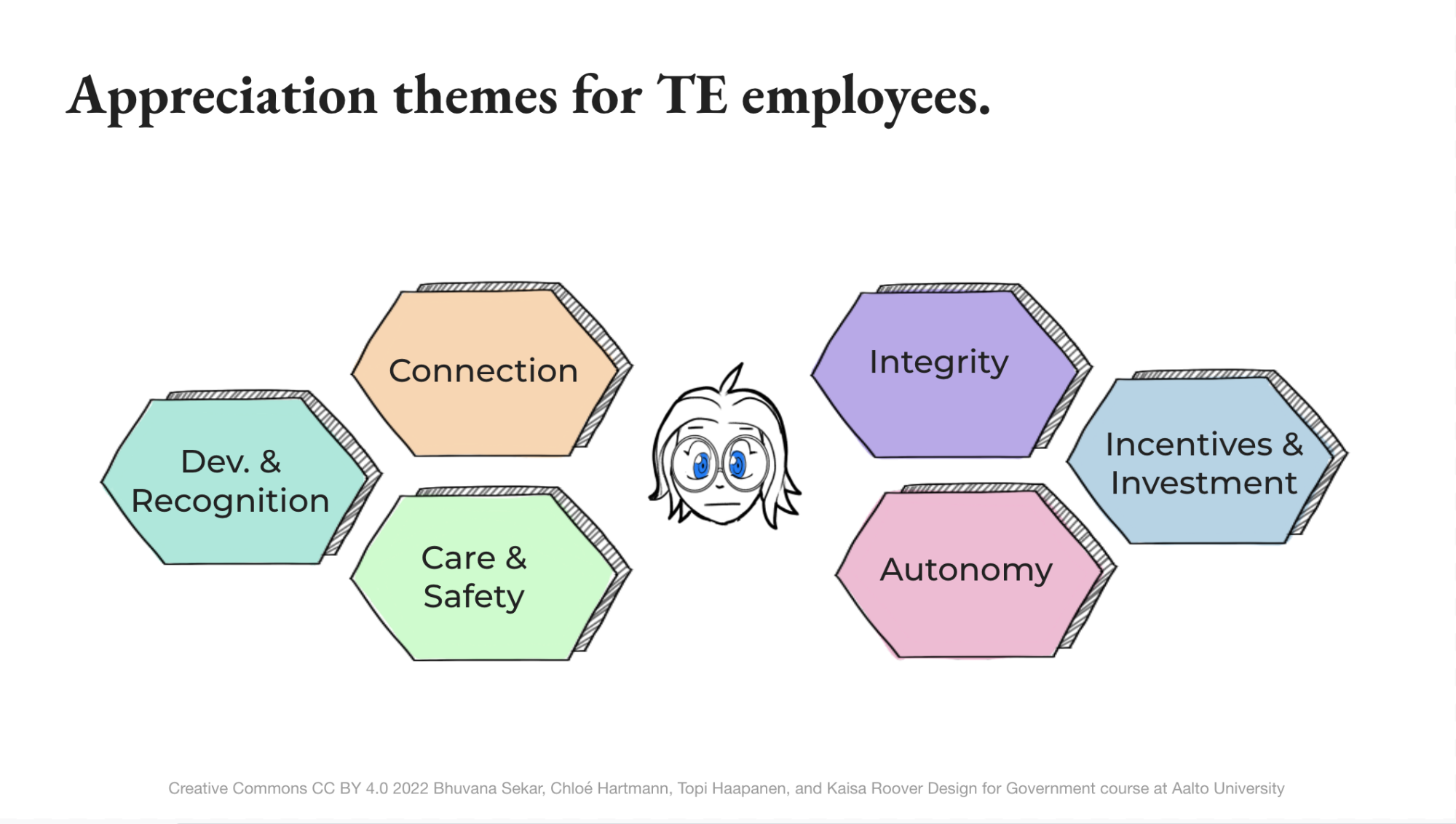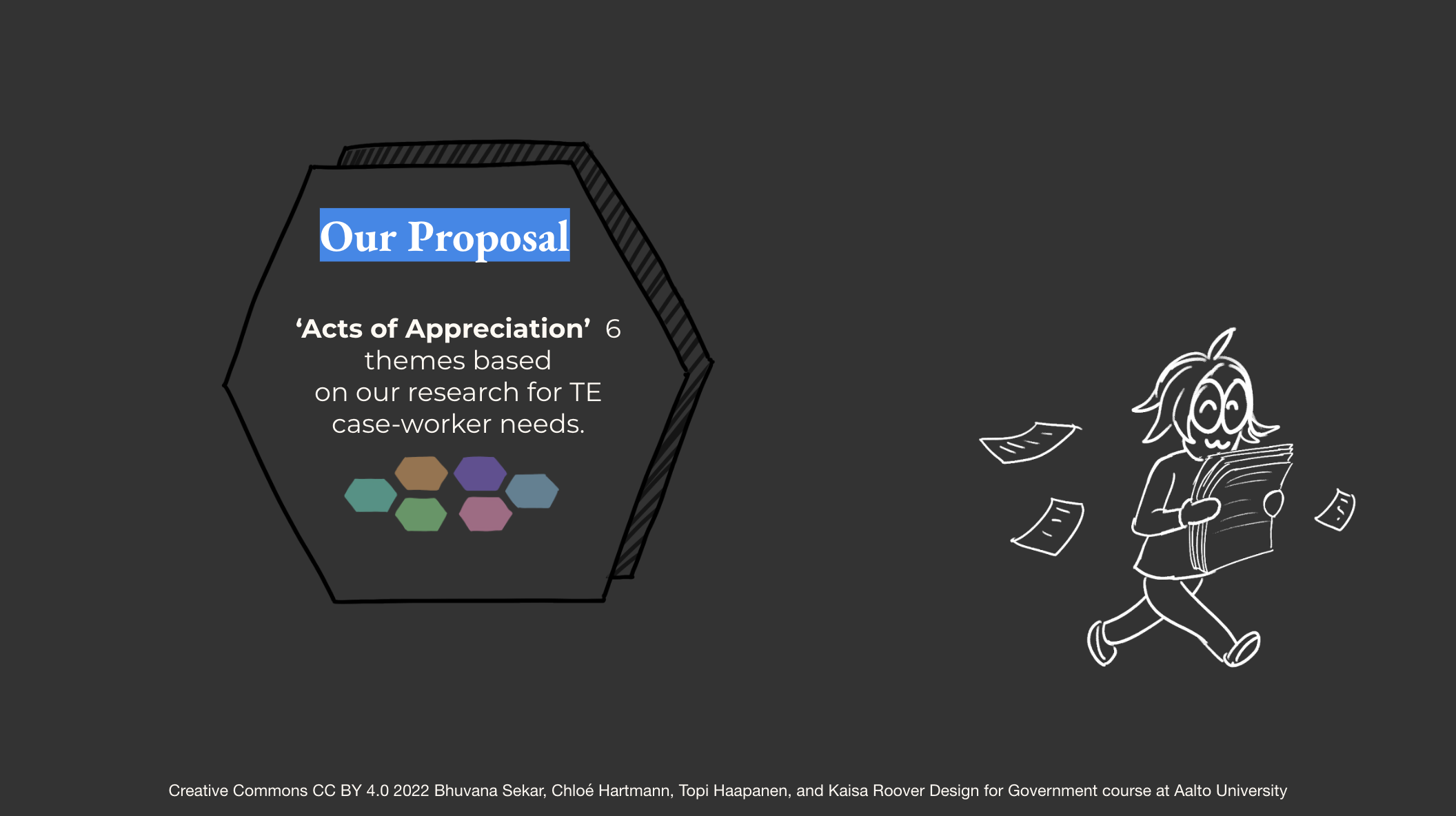This blog post reports on work-in-progress within the DfG course! The post is written by group 2B dealing with the Ministry of Finance’s brief on Orchestrating public governance in employment services (TE2024) by focusing on the public servants’ needs in the new reform model. The group includes Bhuvana Sekar from the Collaborative and Industrial Design program and Chloé Hartmann, Kaisa Roover and Topi Haapanen from the Creative Sustainability program at Aalto University.
Written by: Chloé Hartmann
Three weeks have passed since our last update on this blog. This period gave us time to finalize our solution, validate it with various stakeholders and prepare our presentations for the rehearsal session and the Final Show.
From stuck to unstuck
During the ideation week, we had a call with a caseworker from Helsinki municipality who confirmed our overall understanding of the problem around appreciation in public services and gave us her opinion on how to value caseworkers more. Ultimately, it confirmed to our group how appreciation was missing in public services and gave us confidence regarding our solution. However, one thing was left unclear; what should our exact solution be?
Employee appreciation is usually defined as “the act of recognizing and rewarding employee contributions to the workplace either through formal or informal channels.” (Basu Mallick, 2021). This gives space for various means of action, therefore appreciation culture can be built in various ways. When looking at the literature around it, companies usually incorporate an appreciation culture through small actions. For example, Thomas Griffin -the founder of OptinMonster, interviewed by Forbes (2020)- advises to give “cheers-for-peers”, give shoutouts on social media, offer personalized rewards or celebrate success (employee of the month award).
However, the more we were looking at managerial advice, the more we felt stuck. For example, we felt uncomfortable asking municipality supervisors to give shoutouts to their employees on social media. Was this impactful enough? Couldn’t there be a more holistic approach to it? Moreover, within the context of public services, caseworkers handle very difficult cases. Consequently, helping jobseekers find a job for example can ask for a lot of time, help, and advice which is not considered in the success metrics; making some recommended actions non-applicable.
Instead of having the “aha moment” we were expecting to have by looking at appreciation culture in the corporate world, we felt a gap between what could be done in this environment compared to in public services. Therefore, we took a step back and brainstormed on all the ways caseworkers could be appreciated in municipalities. Possible actions ranged from providing resources for lunch vouchers to hiring a coach to help caseworkers check-in mentally, considering how emotionally draining their job was. We were beginning to feel hopeful again, but what was the actual solution going to be was still blurry.
Appreciation Themes For Public Services
Now that we had our own acts of appreciation, what could we do with them? We decided to categorize them into different pillars. Ultimately, we retained: Development & Recognition, Connection, Care & Safety, Recognition, Integrity, and Incentives & Investment.

Figure 1: Appreciation themes for TE employees.
The rest of the solution then came to us more naturally. Indeed, during our ideation phase, we were feeling inspired by the UK Policy Lab, Government System Framework (2020), which showed different means of action based on the intervention and the context and we wanted to have something similar for appreciation in the workplace but we did not know exactly how. Then we realized that even though we were focusing on caseworkers all along, some acts of appreciation were more formal than others and needed to be set by higher positions. In the Toolkit Framework, we categorised the Appreciation Themes, on the horizontal axis, and the level of intervention, on the vertical axis.

Figure 2: The Toolkit Framework.
Moreover, the main reason why we felt stuck in the process of building our toolkit was that we felt that we were making assumptions about what the acts of appreciation should be and were trying to think of every possible one. Ultimately, we realized that this is where we needed to stop developing our solution as designers and provide this toolkit for municipalities to ideate and bring their own acts of appreciation to their organization. This made even more sense because the TE2024 reform is about giving more freedom to municipalities and this will influence their way of working, hence their appreciation culture will vary.
The complexity of working on organizational culture
From the beginning, we knew that this reform was going to change the organizational culture in municipalities. However, our research phase uncovered an issue that was not only a consequence of this reform but was constantly present. As one municipality supervisor said, “Everyone is aware that we lack an appreciation culture but it is at the bottom of everyone’s priority list.” Ultimately, this issue is persistent and will be an obstacle to the successful implementation of the TE2024 reform.
One obstacle we faced as designers in this project was about believing in the strength of our proposal. Ultimately, our toolkit allowed us to find a tangible, adapted, and holistic way of approaching appreciation of public services. After our presentation at the Final Show, we received positive comments about how these acts of appreciation were needed not only in municipalities but in all public services. Paradoxically, social service workers have one of the most difficult jobs and still are the ones lacking the most appreciation, not only from organizations but from society as well.
When we were sharing our reflections on our solution, one of our tutors mentioned that these acts of appreciation could be seen as little seeds to be implemented in the organization. I thought more about it and this analogy made me realize how complex building an organizational culture is. Culture comes from Latin, cultura which means “growing” or “cultivation”. Ultimately, these acts of appreciation are seeds that will allow the appreciation to grow within public services. With the help of the toolkit and caseworkers to identify needed acts of appreciation, this will put the seeds in the adapted condition to grow.
The key takeaway from this project is that these acts of appreciation can seem small when looking at them individually but then should not be overlooked. Indeed, altogether, they might shift the perspective around social services and build positive change for caseworkers, who are at the heart of this reform.
References
- Basu Mallick, C. (2021). What Is Employee Appreciation? Definition, Strategies, Ideas, And Technology Platforms. Retrieved 24 May 2022, from https://www.toolbox.com/hr/employee-recognition/articles/what-is-employee-appreciation-definition-strategies-ideas/
- Policy Lab. (2020). Introducing a ‘Government as a System’ toolkit – Policy Lab. Retrieved 24 May 2022, from https://openpolicy.blog.gov.uk/2020/03/06/introducing-a-government-as-a-system-toolkit/
- YEC. (2020). Council Post: How To Create A Culture Of Appreciation In Your Team. Retrieved 24 May 2022, from https://www.forbes.com/sites/theyec/2020/10/29/how-to-create-a-culture-of-appreciation-in-your-team/?sh=58e5d32e1147
The DfG course runs for 14 weeks each spring – the 2022 course has now started and runs from 28 Feb to 23 May. It’s an advanced studio course in which students work in multidisciplinary teams to address project briefs commissioned by governmental ministries in Finland. The course proceeds through the spring as a series of teaching modules in which various research and design methods are applied to address the project briefs. Blog posts are written by student groups, in which they share news, experiences and insights from within the course activities and their project development. More information here about the DfG 2022 project briefs.

